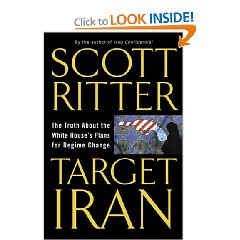 Clever Not Pretentious, Useful and Focused–Valuable to All
Clever Not Pretentious, Useful and Focused–Valuable to All
June 20, 2007
Scott Ritter
This is a clever useful book. I *like* it. It is not pretentious nor is it convoluted. It does a very fine job of explaining to the non-military average activist or leader of activists the utility of Sun Tzu, Clausewitz, and John Boyd in developing a national and global strategy, national and global campaign plans, and local discrete tactical “events” that can achieve impact *only* if done in the context of a strategy and a campaign plan.
The author does a fine job of gently and respectfully pointing out that the current anti-war and pro-environment movements, projects, and individuals have a severe handicap in not understanding the connection between a strategy, and operational campaign, and tactical events planned and executed in the larger context.
The author does a tremendous job of clearly and concisely describing how the extreme right has managed to define its ideological war plan as “Guns, God, and Gays,” while none of the thoughtful but complex, lengthy and somewhat disjointed progressive messages stand a chance.
The author understand that the war for the soul of America and for the stability of the rest of the world is about belief systems, and about capturing as many individual minds and hearts as possible. The extreme right is winning with ideological fantasy while the extreme left is losing in detail for lack of a message that can be adopted by the mainstream, which remains largely apathetic.
The author goes on to articulate a distress that I myself have experienced, politely pointing out that most progressive movements have too many self-named leaders, not enough disciplined followers (for lack of a strategy and campaign plan), and are generally too focused on feel good events or actions. I myself respect all these people, but think of them as the huggy huggy tea party set. They don't know how to bring an enemy system–a domestic enemy system–to a screeching halt in a showdown over time and space.
The author is brilliant–utterly brilliant–in pointing out that there is only one message that can win over the mainstream and the apathetic middle, and that message is “uphold the Constitution and the sovereign power of We the People, with liberty and justice for all.” He *nails* it. I am moved by this book. It is *not* a clever marketing book to add to anyone's financial kitty, this is a book by a patriot, for patriots, and it is useful–actionable–and therefore priceless in value to all of us.
In the middle part of the book, after describing Intelligence Preparation of the Battlefield (IPB), an Army standard, but not discussing the intelligence cycle, the author emphasizes the importance of both psychology, and intelligence: the progressives must “be able to accurately track what an opponent is doing on the battlefield.” I tried to explain this to Howard Dean's staff back in the day, and could not get anyone to listen. Our politicians running for President are not only not qualified to be President, they are not even staffed to offer the voters a coherent range of policies within a balanced sustainable budget. All they can do with all their tens of millions is fire broadsides of platitudes at one another. This is one reason I created the Earth Intelligence Network, in order to both teach the progressives how to create intelligence and policy matrices (the ten threats, twelve policies, and eight challengers) and to do so in a very compelling manner using serious games with embedded reality-based budgets. All this is free, so please; do not interpret this as advertising for profit.
The author draws to a close with three hugely important points:
1) The only message that will resonate with *all* of us is upholding the Constitution (Romney, to his eternal disgrace, has refused to sign the pledge to uphold the Constitution–all others need to be pressed on this point).
2) The progressives need training in both leadership and followership, and I am hugely impressed by the author's provisions on pages 75-77 of specific URLs for specific Incident Command System (ICS) training courses as well as leadership courses. He is very complementary of these materials provided by the Federal Emergency Management Agency (FEMA) and the National Wildlife Coordination Group (funded by taxpayers, naturally, but not now in the active service of taxpayers).
3) The author's third important point in closing is that activism must be global, not just local or national. Most activists understand this intuitively, but the *only* group to actually do something along these lines is the World Index of Environmental and Social Responsibility (WISER) under the conceptual leadership of Paul Hawkin and the technical leadership of Peggy Duvette. Indeed, combining the author's advice and concept of organization with my own vision for the “six bubbles” (see image) of the Earth Intelligence Network is in my mind a useful starting point for the yet to be developed WISER (Self) Government module.
The author offers other useful tidbits in passing, including a definition of how the progressives could organize administrative, intelligence, operational, planning, logistics, communications, and public relations teams with proper training and recognized leadership. He may not be familiar with all the training that is being done along these lines by some, for example those taking on the World Trade Organization, but in general his observations are helpful.
The book ends with two appendices, the U.S. Constitution and the United Nations charter. The author is NOT Jane Fonda on steroids. He sees, quite clearly, that the Republic is in the battle of all time for the soul of democracy and the soul of (moral) capitalism. He understands that the center of gravity is the huge disengaged apathetic “middle” and that until that middle understands that what is being done in our name by the U.S. Government is illegitimate, illegal, immoral, and imprudent, we will not be able to mobilize effectively.
This is a truly fine book, of, by, and for We the People.
See also:
Democracy's Edge: Choosing to Save Our Country by Bringing Democracy to Life
Escaping the Matrix: How We the People can change the world
Society's Breakthrough!: Releasing Essential Wisdom and Virtue in All the People
All Rise: Somebodies, Nobodies, and the Politics of Dignity (Bk Currents)
The Tao of Democracy: Using Co-Intelligence to Create a World That Works for All
The New Craft of Intelligence: Personal, Public, & Political–Citizen's Action Handbook for Fighting Terrorism, Genocide, Disease, Toxic Bombs, & Corruption
THE SMART NATION ACT: Public Intelligence in the Public Interest




